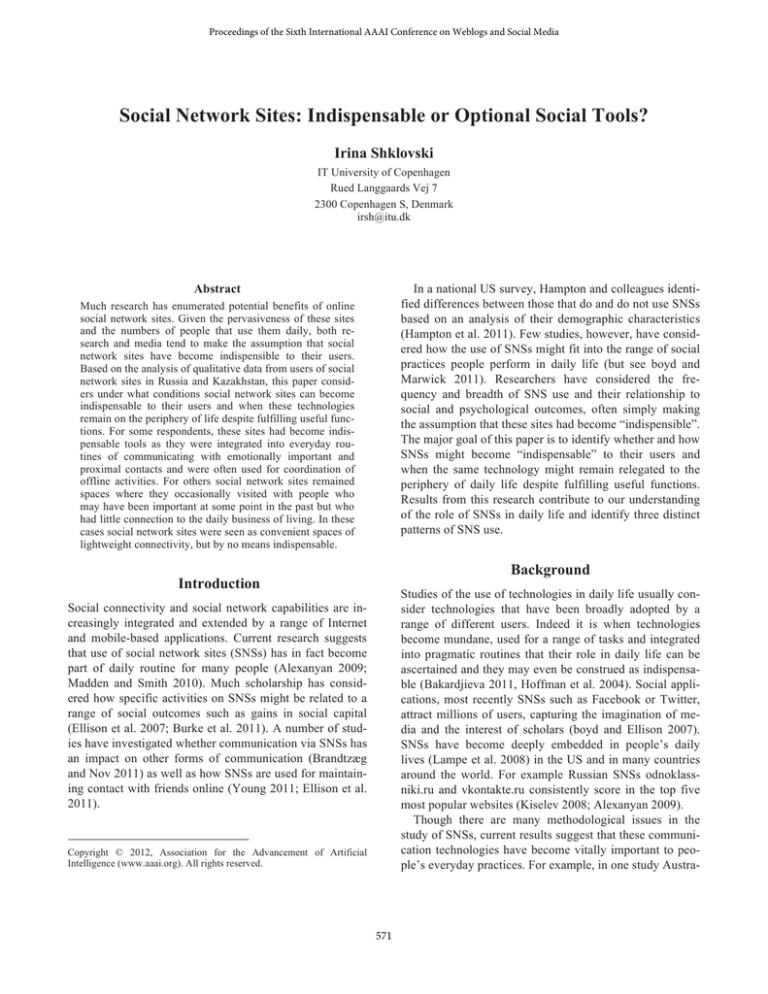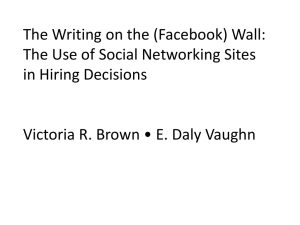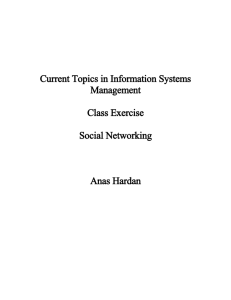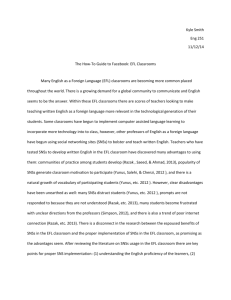
Proceedings of the Sixth International AAAI Conference on Weblogs and Social Media
Social Network Sites: Indispensable or Optional Social Tools?
Irina Shklovski
IT University of Copenhagen
Rued Langgaards Vej 7
2300 Copenhagen S, Denmark
irsh@itu.dk
Abstract
In a national US survey, Hampton and colleagues identified differences between those that do and do not use SNSs
based on an analysis of their demographic characteristics
(Hampton et al. 2011). Few studies, however, have considered how the use of SNSs might fit into the range of social
practices people perform in daily life (but see boyd and
Marwick 2011). Researchers have considered the frequency and breadth of SNS use and their relationship to
social and psychological outcomes, often simply making
the assumption that these sites had become “indispensible”.
The major goal of this paper is to identify whether and how
SNSs might become “indispensable” to their users and
when the same technology might remain relegated to the
periphery of daily life despite fulfilling useful functions.
Results from this research contribute to our understanding
of the role of SNSs in daily life and identify three distinct
patterns of SNS use.
Much research has enumerated potential benefits of online
social network sites. Given the pervasiveness of these sites
and the numbers of people that use them daily, both research and media tend to make the assumption that social
network sites have become indispensible to their users.
Based on the analysis of qualitative data from users of social
network sites in Russia and Kazakhstan, this paper considers under what conditions social network sites can become
indispensable to their users and when these technologies
remain on the periphery of life despite fulfilling useful functions. For some respondents, these sites had become indispensable tools as they were integrated into everyday routines of communicating with emotionally important and
proximal contacts and were often used for coordination of
offline activities. For others social network sites remained
spaces where they occasionally visited with people who
may have been important at some point in the past but who
had little connection to the daily business of living. In these
cases social network sites were seen as convenient spaces of
lightweight connectivity, but by no means indispensable.
Background
Introduction
Studies of the use of technologies in daily life usually consider technologies that have been broadly adopted by a
range of different users. Indeed it is when technologies
become mundane, used for a range of tasks and integrated
into pragmatic routines that their role in daily life can be
ascertained and they may even be construed as indispensable (Bakardjieva 2011, Hoffman et al. 2004). Social applications, most recently SNSs such as Facebook or Twitter,
attract millions of users, capturing the imagination of media and the interest of scholars (boyd and Ellison 2007).
SNSs have become deeply embedded in people’s daily
lives (Lampe et al. 2008) in the US and in many countries
around the world. For example Russian SNSs odnoklassniki.ru and vkontakte.ru consistently score in the top five
most popular websites (Kiselev 2008; Alexanyan 2009).
Though there are many methodological issues in the
study of SNSs, current results suggest that these communication technologies have become vitally important to people’s everyday practices. For example, in one study Austra-
Social connectivity and social network capabilities are increasingly integrated and extended by a range of Internet
and mobile-based applications. Current research suggests
that use of social network sites (SNSs) has in fact become
part of daily routine for many people (Alexanyan 2009;
Madden and Smith 2010). Much scholarship has considered how specific activities on SNSs might be related to a
range of social outcomes such as gains in social capital
(Ellison et al. 2007; Burke et al. 2011). A number of studies have investigated whether communication via SNSs has
an impact on other forms of communication (Brandtzæg
and Nov 2011) as well as how SNSs are used for maintaining contact with friends online (Young 2011; Ellison et al.
2011).
Copyright © 2012, Association for the Advancement of Artificial
Intelligence (www.aaai.org). All rights reserved.
571
lian Facebook users expressed substantial attachment to the
site when asked how they might feel if their profiles ceased
to exist (Young 2011). SNSs do not substitute, but augment the array of modalities that people use for daily social
activities (Brantzæeg and Nov 2011). These sites offer
elaborate systems for perpetuating relational continuity
through explicit articulations of connections and through
unobtrusive and asynchronous behaviors, such as leaving
comments or notes for each other (Young 2011; boyd and
Marwick 2011). SNS users reap social benefits from participating in these technologies, as SNSs enable access to
broader and more heterogeneous networks just a click
away (Ellison et al. 2011; Burke et al. 2011).
Method
The data in this paper comes from a qualitative study of the
role of communication technologies in relational maintenance, conducted in four cities in Russia and three cities
Kazakhstan in 2009 and 2010. I conducted 62 semistructured interviews in Russian with respondents recruited
using a snowball sampling method, initially seeded with
personal contacts. The sample consisted of 30 women and
32 men, ranging in age from 18 to 62 (average 36) and in
education from secondary school to PhD, 28 of the participants were married. The majority of respondents were employed, eight were college students and three were retired.
All interviews began with discussions of geographically
proximal and distant social ties, letting technologies used
for their maintenance emerge organically, without external
prompting. At the end of each interview I asked the respondents how they might react if tomorrow all social network sites suddenly disappeared. Responses to this question form the basis of the analyses reported here.
This investigation was based on the principles of
grounded theory (Corbin and Strauss, 2008). After each
interview, I wrote extensive field notes, charting a picture
of the mediated communication landscape in the lives of
the people I met. I augmented each subsequent interview
based on my reflections on prior interviews. Toward the
end of the study I reached “theoretical saturation” as previously identified concepts and ideas were getting repeated
with few new issues emerging. All presented quotes were
translated by the author, who is a native Russian speaker.
Research Context
The study presented here is based on the data collected in
Russia and Kazakhstan with a focus on how people use a
range of communication technologies for maintaining relationships. With the demise of the Soviet Union resurgence
of nationalism and volatile economic conditions motivated
large swaths of the population to relocate, taking advantage
of greater mobility afforded by the post-soviet states. What
used to be stable local personal networks developed over
the course of a lifetime became unstable connections to
mobile and often long distant contacts (Rose 2000).
Russian-language SNSs have provided an opportunity
for people in Russia to reconnect, re-establishing connections lost due to out-migration and revitalizing more local
connections that have deteriorated due to economic volatility (Alexanyan 2009). SNSs not only continue to be some
of the most popular sites used by the Russian-language
users (Firsova 2011), but have also been credited with motivating users over 50 to start using the Internet with the
promise of reconnection. Although both Russia and Kazakhstan can be construed as ‘digitally nascent’ societies
(Wei and Kolko 2005), the percentage of Internet users in
these countries is rapidly increasing. SNSs are wildly
popular among Internet users in the region. Nearly two
thirds of all users report having at least one social network
site profile and this is even more prevalent among users
over 50 (Skanavi 2011).
Given the prominence of SNSs in daily Internet use in
Russia and Kazakhstan it is reasonable to assume that in
spite of the fact that these technologies fairly recently became part of online offerings for Russians, they have become important to their users. Yet it is unclear what such
importance might mean in everyday life. This study considered how people in Russia and Kazakhstan integrated
SNS use into a range of their social activities and whether
these sites were indeed perceived as indispensible.
Findings
Most of the respondents maintained an account on more
than one SNS although the vast majority actively used only
one account if they had it. Only a about a third of respondents (n=26) used SNSs in concert with other communication technologies to maintain current active connections as
well as to keep track of connections that had become dormant. The rest used SNSs primarily to reconnect with people with whom they had lost contact over the years.
The frequency of SNS use varied from being logged
onto the site constantly either from stationary computers or
mobile phones to only checking them in response to email
notifications of messages or other SNS activity. More than
half of the respondents reported checking at least one SNS
daily (n=34). Usually if respondents had more than one
SNS profile they used one frequently and checked the others in response to notifications. While there was a general
trend for respondents under 30 to be more active users of
SNSs than those over 30, there were a number of exceptions to this trend in both age groups. On average, users
who used SNSs daily tended to report spending between 30
minutes and an hour on their site of choice.
572
Well that would be a really serious loss, because I
have a kind of community inside those, not people I
know in person but people that are my network interlocutors and I wouldn’t want to loose these people. –
AT, 36, Russia
Importance of SNSs
At the end of every interview we asked: “if you were to
wake up tomorrow and find that all SNSs suddenly disappeared, how would you react to this?” This question was
deliberately constructed to ask about loss of SNSs in general for everyone rather than asking about loss of individual access to SNSs as for example in the Young (2011)
study. We were interested in ascertaining the role of this
technology in daily life more generally, rather than considering how individuals might feel about sudden exclusion if
they were the only ones to loose access. Respondents
tended to react with three broad categories of response:
horror and a sense of profound loss, slight irritation at resulting inconveniences and a calm shrug indicating that it
would make no difference to them. There were few simple
demographics that were consistently associated with each
type of response. While there was a trend for older respondents to express a kind of nonchalance toward potential
loss of SNSs, younger respondents were as likely to express any of the three attitudes and there were a number of
older respondents expressing other attitudes as well. Levels
of income and education were not unassociated with patterns of response. We found distinct patterns of SNS use
that were associated with each type of response.
In this case, not only were SNSs used for maintaining
offline relationships, they were also sites for making new
online connections. It was these connections that represented the value of SNS connectivity and, since SNSs were
the only space of their enactment they would be then irreversibly lost. These kinds of responses, full of emotional
reactions to what respondents imagined would be profound
losses, were what one might expect given the recent scholarship on SNSs. Yet only a small proportion of our respondents had expressed this kind of sentiment.
SNS as an Organizational Convenience
Another, somewhat more common response (n=21) could
be summarized as a kind of calm description of potential
inconveniences that was usually amended with considerations of potential positive outcomes:
The fact is it would be inconvenient, I would receive
information much slower. Some of my habits would
probably have to change. Like this I am constantly
expressing ideas and I would have to change that. It
would be harder to organize events – MD, 20, Russia
SNS as an Indispensible Tool
This kind of response did not contain the emotional reaction to a kind of profound loss expressed earlier. Here,
the attitude was far more practical – a consideration of
loosing a useful and often frequently used tool. The loss
here was merely an inconvenience, albeit one that might
have substantial consequences. Some respondents even
considered that these inconveniences might be imagined:
I would experience a little bit of an information vacuum or at least it might seem to me that I am in such a
vacuum, but it wouldn’t really change anything. –
KSH, 36, Russia
A small proportion of respondents (n=14) reacted with
expressions of profound loss:
It would be really sad, I would really miss something.
I think it would be similar if tomorrow I woke up and
found that refrigerators or TVs were gone! Actually, I
think I could live without TV easier. – LF, 50, Russia
Such commentary illustrated that for some of the respondents loss of SNSs would mean a profound disruption
to their daily activities. The comparison of the SNS to TV
and refrigerator here evocatively illustrates how for this
respondent SNSs had become a common utility and part of
the infrastructure that supported her daily practices. In fact
these practices explicitly related to interactions and relational maintenance activities with emotionally close and
often physically proximal contacts. Most commonly, SNSs
also offered a way to communicate that allowed circumnavigating difficult or inconvenient circumstances.
Well you can’t call her at night, you know, her mother
is bed-ridden and she takes care of her. So I see if she
is online, I send her a message and I know she will respond when she has a minute. I’d rather not call to
distract her too much. – LF, 50, Russia.
While SNSs were frequently used as organizational and
information resources, when asked to consider their value,
many respondents referred to the time-investments necessary to make them useful, often reflecting that other tools
could easily fulfill similar functions without the distraction
of the social minutiae of SNS.
SNS as a Tool for Reconnection
A somewhat larger proportion of the participants (n=27),
however, responded with a kind of careless shrug indicating that loss of SNSs wouldn’t make much difference in
their lives at least at this juncture.
Well it wouldn’t be a big deal, I already did everything I wanted to, found information and I am really
satiated with it. Those that are on the Internet and
those that make up my [friends] I can’t say that I can’t
Another response of this type referred to loss of particular social contacts that had been gained specifically
through the SNS and that had developed into engaging
connections:
573
live without them, I had lived most of my life without
them, at our age people leave. – SB, 50, Kazakhstan
Acknowledgements
In most cases these respondents had been using the SNS
for several years and tended to primarily use them for finding connections from the past and reconnecting with them.
While it is tempting to associate such sentiments with a
particular age group, however, this wasn’t the case:
I wouldn’t be particularly broken up about it, I didn’t
really interact with most people on there. Those people that are really interesting to me, I have their contact information so even without [SNS] there are other
ways. – NM, 28, Russia
I am indebted to all of the respondents for their generous
participation in our study. This research was funded by the
NSF grant IIS-0917401. Any opinions, findings, conclusions or recommendations expressed in this material are
those of the authors and do not reflect the views of the National Science Foundation.
References
Alexanyan, K. 2009. Social networking on Runet: The view from
a moving train. Digital Icons: Studies in Russian, Eurasian and
Central European New Media 1 (2):1-12.
Bakardjieva, M. 2011. Reconfiguring the mediapolis: New media
and civic agency. New Media & Society.
boyd, d. and Marwick, A. E. 2011. Social Privacy in Networked
Publics: Teens’ Attitudes, Practices, and Strategies. Paper presented at A Decade in Internet Time Symposium Oxford, UK:
Available at: http://ssrn.com/abstract=1925128
Brandtzæg, P., and Nov, O. 2011. Facebook use and social capital
- a longitudinal study. In proceedings of the Fifth International
AAAI Conference on Weblogs and Social Media: AAAI Press
Burke, M., Kraut, R. and Marlow, C. 2011. Social capital on facebook: differentiating uses and users. In Proceedings of CHI. Vancouver, BC, Canada: ACM.
Corbin, J. M., and Strauss A. L. 2008. Basics of qualitative research: Techniques and procedures for developing grounded
theory. 3rd ed. Los Angeles, CA: Sage.
Ellison, N., Steinfield, C. and Lampe, C. 2011. Connection
strategies: Social capital implications of Facebook-enabled communication practices. New Media & Society 13 (6):873-92.
Firsova, T. 2011. 5 Saitov: Ostat'sya v Zhiv'yh. Paper presented
at RIF+KIB. Lesnye Dali resort, Russia.
Hampton, K., Sessions Goulet, L., Rainie, L. and Purcell, K.
2011. "Social networking sites and our lives." Washington, DC:
Pew Internet & American Life Project.
Hoffman, D., Novak, T. P. and Venkatesh, A. 2004. Has the Internet become indispensable? Communications of the ACM 47
(7):37-42.
Kiselev, N. 2008. Social Networks as Instruments of PR. Moscow: International PR Club.
Lampe, C., Ellison, N. B. and Steinfield, C. 2008. "Changes in
use and perception of Facebook." In proceedings of CSCW San
Diego, CA:ACM
Madden, M., and Smith, A. 2010. Reputation management and
social media. Washington, DC: Pew Internet & American Life
Project.
Skanavi, A. "Drugie" (Te Komu Za 50) V Internete. 2011 Paper
presented at RIF+KIB Lesnye Dali resort, Russia
Wei, C. Y., and Kolko, B. 2005. Resistance to globalization: Language and Internet diffusion patterns in Uzbekistan. New Review
of Hypermedia and Multimedia 11 (2):205 - 20.
Young, K. 2011. Social ties, social networks and the Facebook
experience. International Journal of Emerging Technologies and
Society 9 (1):20-34.
Such nonchalance was initially startling given that many
of the respondents were spending countless hours daily on
their SNS of choice catching up with former classmates
and exchanging fresh gossip. Yet here the loss of SNSs
was not perceived as something disruptive because the
contact that would have been lost was never integrated into
the practice of daily living. Spending time on SNSs was a
form of entertainment, disconnected from the everyday
realities. Reconnected ties may have been exciting or important for reminiscence, but not imperative otherwise.
Discussion and Conclusions
This paper considered what role SNSs play in how people
conduct activities of daily living, identifying three broad
patterns of use given three different reactions in response
to the question of whether SNSs were important. These
reactions were strongly associated with specific use practices that have implications for considering how to conceive of and design social applications in the future. Where
all respondents engaged in reconnecting with contacts from
the past, looking up each others’ photographs and exchanging messages about current activities, fewer used the sites
as organizational tools, ways of accessing media and entertainment or as information sources and even fewer used
SNSs to actively communicate with contacts that represented strong relationships and emotional involvements.
SNSs did in fact become indispensable tools for some but
only when their use was integrated into the everyday routines of communicating with emotionally important or
geographically proximal contacts. For many users, however, social network sites were like a box of cookies – a
source of immediate gratification, whose imagined absence
could easily be replaced by other activities. The ease of
communication made SNS use lively and entertaining, but
the use of these sites remained largely inconsequential unless it underpinned actions that traveled outside of the social network site itself.
574





